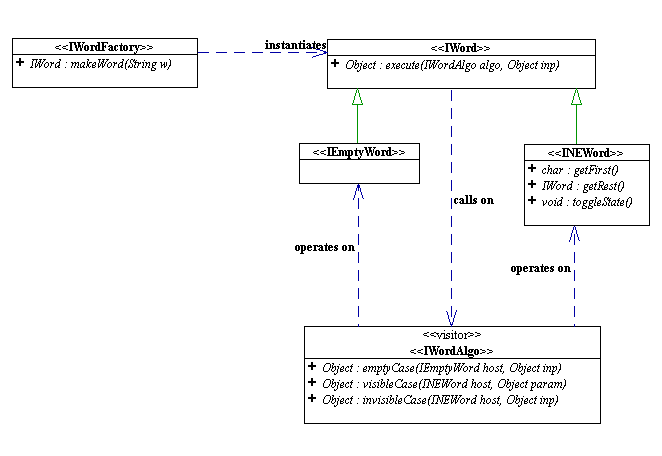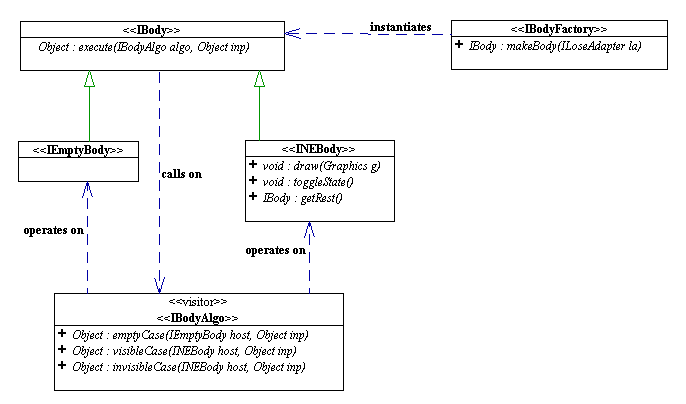
|
|
Comp202: Principles of Object-Oriented Programming II
|
Quick links to supporting pages: BodyParts, MVC, Sounds, View & controller, WordList
This programming project is designed to make use of linear recursive structures. It also serves as an example of how to write Graphical User Interface (GUI) programs using the Model-View-Controller (MVC) pattern.
You are to write a Java GUI application that allows you to play the game of "Hangman." In case you've forgotten, that's the game where there's a hidden word or phase and the player attempts to guess it one letter (character) at a time. Every correct guess results in that letter being exposed and every incorrect guess results in a body materializing part by part on a gallows. The game is won when all the letters of the answer have been guessed before a complete body is drawn hanging on the gallows. Let's play hangman.
Click here to run a demo of the Hangman project!
Game Interactions |
Word Display |
Scaffold Display |
| Computer displays a word for the user to guess and an "empty" scaffold. | _ _ _ _ _ | Scaffold with no body parts. |
| User guesses 'X': | ||
| Computer displays: | _ _ _ _ _ | Scaffold with a head |
| User guesses 'E': | ||
| Computer displays: | _ _ _ _ _ | Scaffold with a head and a torso |
| User guesses 'A' | ||
| Computer displays: | _ _ _ _ A | Scaffold with a head, and a torso |
| User guesses 'R' | ||
| Computer displays: | _ _ _ _ A | Scaffold with a head, a torso, and a right arm |
| etc... | ||
If we are to write a program that plays hangman as shown, what are the components of such a program?
At a very high level, the program
accepts a user's input,
performs some internal computations based on the input, and
displays the results in some useful forms.
The above functionalities of the program must be delineated and encapsulated in separate components in order to achieve a high degree of flexibility and extensibility. A tried-and-true design pattern, called Model-View-Controller (MVC), is best suited for programs like the above.
The MVC design pattern calls for breaking up programs that interact with the users and display the results based on the users' inputs into three major components.
The Model: the data structures and algorithms on the structures.
The View: the display, which may be a GUI or non-GUI.
The Controller: the "wiring" between the Model and the View.
First, go read about the MVC pattern here.
You are required to implement the program in accordance with the following design specifications. We will be giving you the system design but that will not be a future trend.
At the highest level, the total Hangman game design uses a Model-View-Controller design pattern to decouple the internal workings of the game from the GUI.
The underlining data model should consist of the following linear recursive structures.


The above data models are encapsulated into a single class that represents the operational model of the Hangman game, called (duh) HangmanGame. This class can initialize the game, allow guesses of characters, show what characters in the answer have been correctly guessed, draw onto a supplied graphics surface the body parts associated with incorrect guesses, and finally to indicate whether the game has been won or lost.

Nothing in the model should contain any explicit references to the GUI and vice versa. Instead, communication from the model to the view uses the interface IGameAdapter .
How To Lose When You Don't Know How...When the noose is drawn, the game is over. But the problem is that the noose is a body part and has no idea how to actually end the game. Hence, the inclusion of the ILoseAdapter (See the bodyparts package ). This command is called when the noose is drawn and is used to signal the rest of the system that the game has ended. But the question is who is signaled? Does the view get notified directly or are there some "housekeeping chores" that need to be performed before the view is notified? Who would do these "clean-up" tasks and does the view already have a means of being notified that the game has ended?
The GUI should have the following features:
As the model object is unaware of the GUI (view), so the view object should not know anything about the model that it is displaying. All communication from the view to the model is through 2 interfaces: IPaintAdapter and IGameControlAdapter.
Anonymous inner classes will be used extensively to connect the view (HangmanGUI) to its GUI components (buttons, text fields, labels, etc.);

The controller's job is to
As in the view, anonymous inner classes will be used to instantiate the 3 interface adapters.

The full documentation for the project can be found here.
You will use a number of design patterns in this project. Here are links for more information about them:
JavaResources site on www.exciton.cs.rice.edu
The project is broken up into two milestones. Each milestone is to be submitted electronically. The complete milestone set should contain the following:
Milestone #1: See the Class Schedule for the due date. (50% of total project grade)- Implementation of IWord and IBody, their subclasses and their supporting classes. Write your own client to test your system. The test client need not be a GUI application. You are free to reuse/modify the code we provide you, implement your own design using your own classes, as long as you adhere to the general program requirements.
Relevant links:
The functionality requirement for this milestone is the "Checklist" at the bottom of the bodyparts package web page.
To turn in Milestone 1: Zip up your entire
Hangman directory and upload it as HW01, using the the assignment upload
web page.
RECOMMENDATION
Backup your entire Milestone 1 Hangman folder BEFORE commencing on Milestone 2!
Milestone #2: See the Class Schedule for the due date. (50% of total project grade)- Implementation of a GUI view to control the model. . You will be given the controller code and are free to implement your own design using your own classes, as long as you adhere to the general program requirements. The controller code should connect the model to the view and result in a fully functional game.
Relevant links:
The functionality requirement for this milestone is the "Checklist" at the bottom of the view and controller packages web page.
To turn in Milestone 2: Zip up your entire
Hangman directory and upload it as HW02, using the the assignment upload
web page.
Last Revised Thursday, 03-Jun-2010 09:52:20 CDT
©2006 Stephen Wong and Dung Nguyen